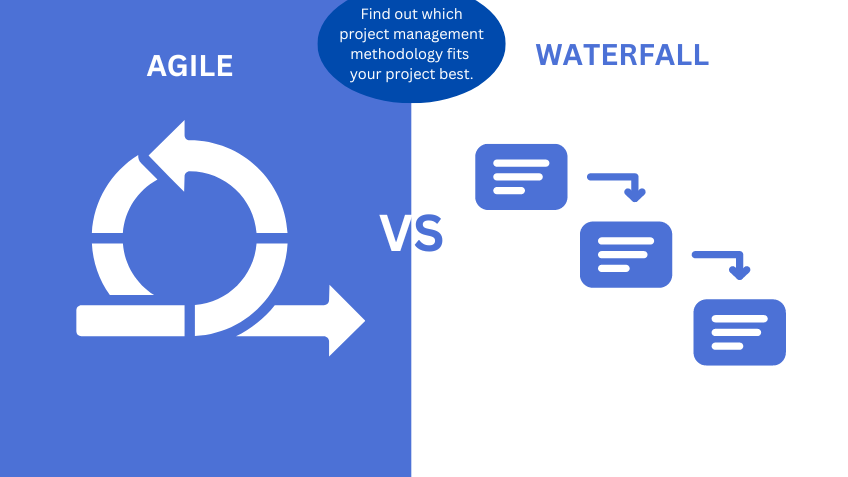
In the realm of project management, choosing the right methodology can significantly impact the success of your project.Two of the most widely used methodologies are Agile and Waterfall. Each has its own unique approach, strengths, and weaknesses, making them suitable for different types of projects. This blog will delve into the key differences between Agile and Waterfall, helping you determine which methodology fits your project best.
Understanding Agile Methodology
Agile methodology is a cyclical and progressive approach to project management and software development. It emphasizes flexibility, collaboration, and customer satisfaction. Agile breaks down projects into small, manageable units called sprints, typically lasting two to four weeks. Each sprint results in a potentially shippable product increment, allowing teams to gather feedback and make adjustments quickly.
Key Characteristics of Agile
- Collaboration: Emphasizes teamwork, communication, and collaboration with stakeholders and customers.
- Customer-Centric: Frequent delivery of product increments ensures continuous customer feedback and satisfaction.
- Iterative Development: Projects are divided into sprints, with each sprint delivering a part of the final product.
Continuous Improvement: Regular retrospectives and reviews facilitate ongoing process improvements.
Understanding Waterfall Methodology
Waterfall methodology is a structured and step-by-step approach to project management. It is often referred to as the traditional project management method. Waterfall involves a series of distinct phases, each completed before moving on to the next. These phases typically include requirements gathering, design, development, testing, deployment, and maintenance.
Key Characteristics of Waterfall
- Linear Process: Follows a strict sequence of phases, with each phase dependent on the completion of the previous one.
- Defined Requirements: Requires thorough documentation and clear requirements before starting the project.
- Predictability: Provides a clear project timeline and milestones, making it easier to manage and predict outcomes.
- Less Flexibility: Changes are difficult to implement once the project is underway, as it requires revisiting and revising completed phases.
- Documentation-Driven: Emphasizes comprehensive documentation for each phase of the project.
Comparing Agile and Waterfall
Project Scope and Requirements
- Agile: Ideal for projects with evolving or unclear requirements. Agile’s iterative nature allows teams to adapt to changes and refine the product based on continuous feedback.
- Waterfall: Suitable for projects with well-defined and stable requirements. Once the project scope is set, Waterfall follows a structured path to completion.
Flexibility and Adaptability
- Agile: Highly flexible, allowing for changes and adjustments at any stage. This adaptability is beneficial in fast-paced environments or projects with uncertain outcomes.
- Waterfall: Less flexible, as changes are challenging to incorporate once a phase is completed. This rigidity can be advantageous for projects with strict timelines and fixed requirements.
Team Collaboration and Communication
- Agile: Promotes regular communication, collaboration, and teamwork. Daily stand-ups, sprint reviews, and retrospectives ensure continuous engagement and alignment.
- Waterfall: Communication tends to be more formal and phase-driven. Teams may work in silos, with interactions primarily occurring at phase transitions.
Risk Management
- Agile: Incremental deliveries and regular feedback reduce risks by identifying and addressing issues early. Agile’s iterative approach allows for quick course corrections.
- Waterfall: Risks are often addressed through thorough planning and documentation. However, issues identified later in the project can be costly and time-consuming to resolve.
Customer Involvement
- Agile: Customers are actively involved throughout the project, providing feedback and validation at the end of each sprint. This continuous engagement ensures the final product meets customer needs.
- Waterfall: Customer involvement is usually confined to the initial requirements gathering and the final delivery phases. This can lead to a disconnect between customer expectations and the delivered product.
Choosing the Right Methodology
When deciding between Agile and Waterfall, consider the nature of your project, the clarity of requirements, the need for flexibility, and the level of customer involvement. Agile is well-suited for projects that require adaptability, frequent iterations, and close collaboration. Waterfall, on the other hand, is ideal for projects with well-defined requirements, a linear progression, and a clear timeline.
Conclusion
Both Agile and Waterfall methodologies have their place in project management. By understanding their strengths and weaknesses, you can choose the approach that best aligns with your project’s goals and requirements. Whether you prioritize flexibility and customer feedback or predictability and structured processes, selecting the right methodology will help you navigate your project to a successful conclusion.